Salvatore Distefano
Dynamic Memory-enhanced Transformer for Hyperspectral Image Classification
Apr 17, 2025Abstract:Hyperspectral image (HSI) classification remains a challenging task due to the intricate spatial-spectral correlations. Existing transformer models excel in capturing long-range dependencies but often suffer from information redundancy and attention inefficiencies, limiting their ability to model fine-grained relationships crucial for HSI classification. To overcome these limitations, this work proposes MemFormer, a lightweight and memory-enhanced transformer. MemFormer introduces a memory-enhanced multi-head attention mechanism that iteratively refines a dynamic memory module, enhancing feature extraction while reducing redundancy across layers. Additionally, a dynamic memory enrichment strategy progressively captures complex spatial and spectral dependencies, leading to more expressive feature representations. To further improve structural consistency, we incorporate a spatial-spectral positional encoding (SSPE) tailored for HSI data, ensuring continuity without the computational burden of convolution-based approaches. Extensive experiments on benchmark datasets demonstrate that MemFormer achieves superior classification accuracy, outperforming state-of-the-art methods.
EnergyFormer: Energy Attention with Fourier Embedding for Hyperspectral Image Classification
Mar 11, 2025Abstract:Hyperspectral imaging (HSI) provides rich spectral-spatial information across hundreds of contiguous bands, enabling precise material discrimination in applications such as environmental monitoring, agriculture, and urban analysis. However, the high dimensionality and spectral variability of HSI data pose significant challenges for feature extraction and classification. This paper presents EnergyFormer, a transformer-based framework designed to address these challenges through three key innovations: (1) Multi-Head Energy Attention (MHEA), which optimizes an energy function to selectively enhance critical spectral-spatial features, improving feature discrimination; (2) Fourier Position Embedding (FoPE), which adaptively encodes spectral and spatial dependencies to reinforce long-range interactions; and (3) Enhanced Convolutional Block Attention Module (ECBAM), which selectively amplifies informative wavelength bands and spatial structures, enhancing representation learning. Extensive experiments on the WHU-Hi-HanChuan, Salinas, and Pavia University datasets demonstrate that EnergyFormer achieves exceptional overall accuracies of 99.28\%, 98.63\%, and 98.72\%, respectively, outperforming state-of-the-art CNN, transformer, and Mamba-based models. The source code will be made available at https://github.com/mahmad000.
Hybrid State-Space and GRU-based Graph Tokenization Mamba for Hyperspectral Image Classification
Feb 10, 2025



Abstract:Hyperspectral image (HSI) classification plays a pivotal role in domains such as environmental monitoring, agriculture, and urban planning. However, it faces significant challenges due to the high-dimensional nature of the data and the complex spectral-spatial relationships inherent in HSI. Traditional methods, including conventional machine learning and convolutional neural networks (CNNs), often struggle to effectively capture these intricate spectral-spatial features and global contextual information. Transformer-based models, while powerful in capturing long-range dependencies, often demand substantial computational resources, posing challenges in scenarios where labeled datasets are limited, as is commonly seen in HSI applications. To overcome these challenges, this work proposes GraphMamba, a hybrid model that combines spectral-spatial token generation, graph-based token prioritization, and cross-attention mechanisms. The model introduces a novel hybridization of state-space modeling and Gated Recurrent Units (GRU), capturing both linear and nonlinear spatial-spectral dynamics. GraphMamba enhances the ability to model complex spatial-spectral relationships while maintaining scalability and computational efficiency across diverse HSI datasets. Through comprehensive experiments, we demonstrate that GraphMamba outperforms existing state-of-the-art models, offering a scalable and robust solution for complex HSI classification tasks.
DiffFormer: a Differential Spatial-Spectral Transformer for Hyperspectral Image Classification
Dec 23, 2024



Abstract:Hyperspectral image classification (HSIC) has gained significant attention because of its potential in analyzing high-dimensional data with rich spectral and spatial information. In this work, we propose the Differential Spatial-Spectral Transformer (DiffFormer), a novel framework designed to address the inherent challenges of HSIC, such as spectral redundancy and spatial discontinuity. The DiffFormer leverages a Differential Multi-Head Self-Attention (DMHSA) mechanism, which enhances local feature discrimination by introducing differential attention to accentuate subtle variations across neighboring spectral-spatial patches. The architecture integrates Spectral-Spatial Tokenization through three-dimensional (3D) convolution-based patch embeddings, positional encoding, and a stack of transformer layers equipped with the SWiGLU activation function for efficient feature extraction (SwiGLU is a variant of the Gated Linear Unit (GLU) activation function). A token-based classification head further ensures robust representation learning, enabling precise labeling of hyperspectral pixels. Extensive experiments on benchmark hyperspectral datasets demonstrate the superiority of DiffFormer in terms of classification accuracy, computational efficiency, and generalizability, compared to existing state-of-the-art (SOTA) methods. In addition, this work provides a detailed analysis of computational complexity, showcasing the scalability of the model for large-scale remote sensing applications. The source code will be made available at \url{https://github.com/mahmad000/DiffFormer} after the first round of revision.
Spectral-Spatial Transformer with Active Transfer Learning for Hyperspectral Image Classification
Nov 27, 2024



Abstract:The classification of hyperspectral images (HSI) is a challenging task due to the high spectral dimensionality and limited labeled data typically available for training. In this study, we propose a novel multi-stage active transfer learning (ATL) framework that integrates a Spatial-Spectral Transformer (SST) with an active learning process for efficient HSI classification. Our approach leverages a pre-trained (initially trained) SST model, fine-tuned iteratively on newly acquired labeled samples using an uncertainty-diversity (Spatial-Spectral Neighborhood Diversity) querying mechanism. This mechanism identifies the most informative and diverse samples, thereby optimizing the transfer learning process to reduce both labeling costs and model uncertainty. We further introduce a dynamic freezing strategy, selectively freezing layers of the SST model to minimize computational overhead while maintaining adaptability to spectral variations in new data. One of the key innovations in our work is the self-calibration of spectral and spatial attention weights, achieved through uncertainty-guided active learning. This not only enhances the model's robustness in handling dynamic and disjoint spectral profiles but also improves generalization across multiple HSI datasets. Additionally, we present a diversity-promoting sampling strategy that ensures the selected samples span distinct spectral regions, preventing overfitting to particular spectral classes. Experiments on benchmark HSI datasets demonstrate that the SST-ATL framework significantly outperforms existing CNN and SST-based methods, offering superior accuracy, efficiency, and computational performance. The source code can be accessed at \url{https://github.com/mahmad000/ATL-SST}.
Attention Mechanism Meets with Hybrid Dense Network for Hyperspectral Image Classification
Jan 04, 2022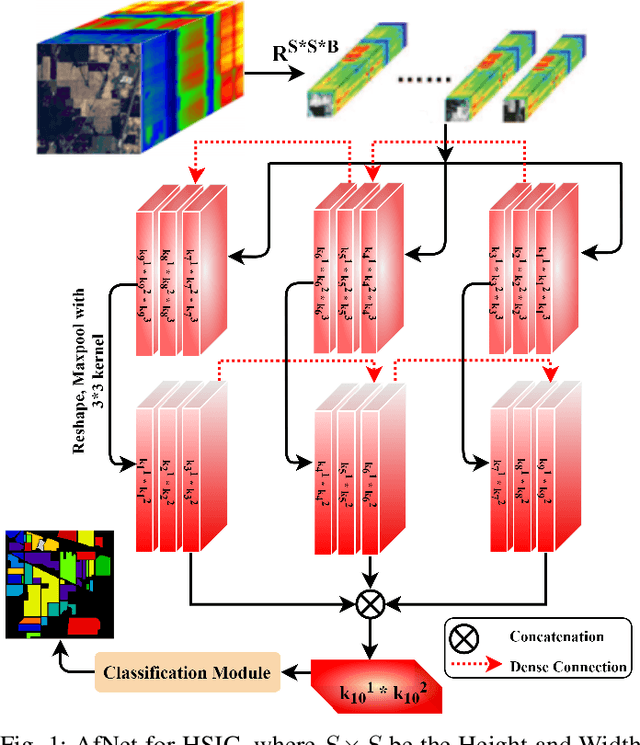

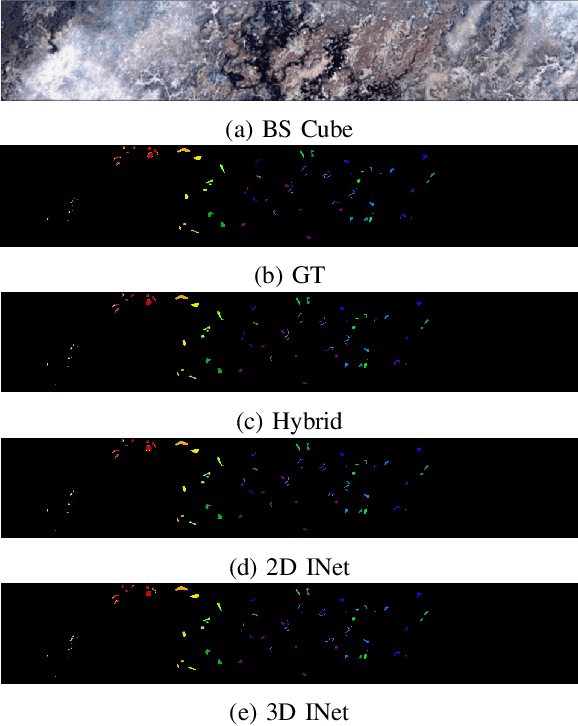
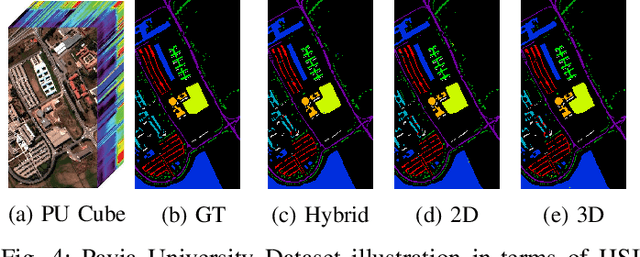
Abstract:Convolutional Neural Networks (CNN) are more suitable, indeed. However, fixed kernel sizes make traditional CNN too specific, neither flexible nor conducive to feature learning, thus impacting on the classification accuracy. The convolution of different kernel size networks may overcome this problem by capturing more discriminating and relevant information. In light of this, the proposed solution aims at combining the core idea of 3D and 2D Inception net with the Attention mechanism to boost the HSIC CNN performance in a hybrid scenario. The resulting \textit{attention-fused hybrid network} (AfNet) is based on three attention-fused parallel hybrid sub-nets with different kernels in each block repeatedly using high-level features to enhance the final ground-truth maps. In short, AfNet is able to selectively filter out the discriminative features critical for classification. Several tests on HSI datasets provided competitive results for AfNet compared to state-of-the-art models. The proposed pipeline achieved, indeed, an overall accuracy of 97\% for the Indian Pines, 100\% for Botswana, 99\% for Pavia University, Pavia Center, and Salinas datasets.
3D/2D regularized CNN feature hierarchy for Hyperspectral image classification
Apr 25, 2021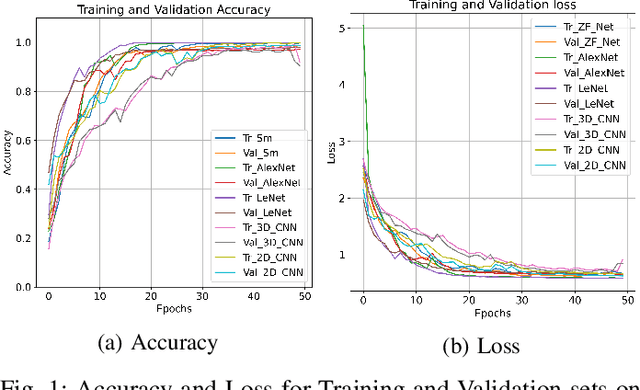

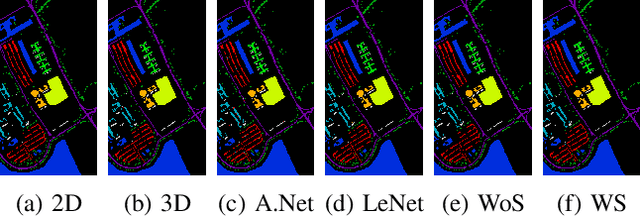
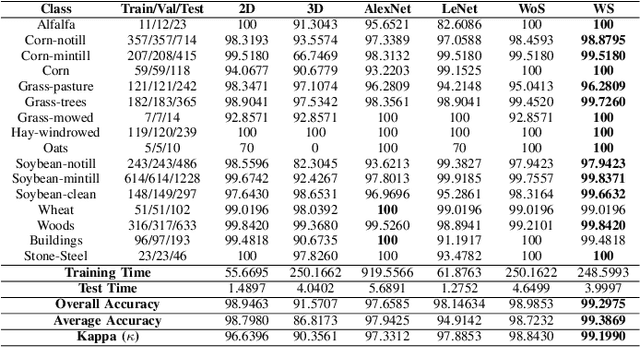
Abstract:Convolutional Neural Networks (CNN) have been rigorously studied for Hyperspectral Image Classification (HSIC) and are known to be effective in exploiting joint spatial-spectral information with the expense of lower generalization performance and learning speed due to the hard labels and non-uniform distribution over labels. Several regularization techniques have been used to overcome the aforesaid issues. However, sometimes models learn to predict the samples extremely confidently which is not good from a generalization point of view. Therefore, this paper proposed an idea to enhance the generalization performance of a hybrid CNN for HSIC using soft labels that are a weighted average of the hard labels and uniform distribution over ground labels. The proposed method helps to prevent CNN from becoming over-confident. We empirically show that in improving generalization performance, label smoothing also improves model calibration which significantly improves beam-search. Several publicly available Hyperspectral datasets are used to validate the experimental evaluation which reveals improved generalization performance, statistical significance, and computational complexity as compared to the state-of-the-art models. The code will be made available at https://github.com/mahmad00.
Hyperspectral Image Classification: Artifacts of Dimension Reduction on Hybrid CNN
Jan 25, 2021
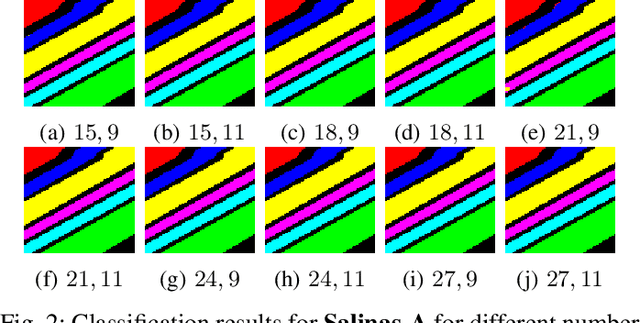
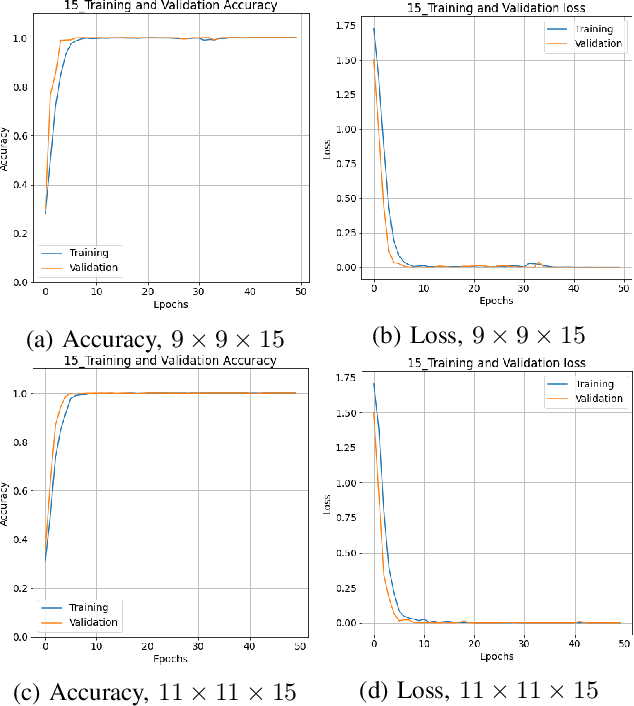
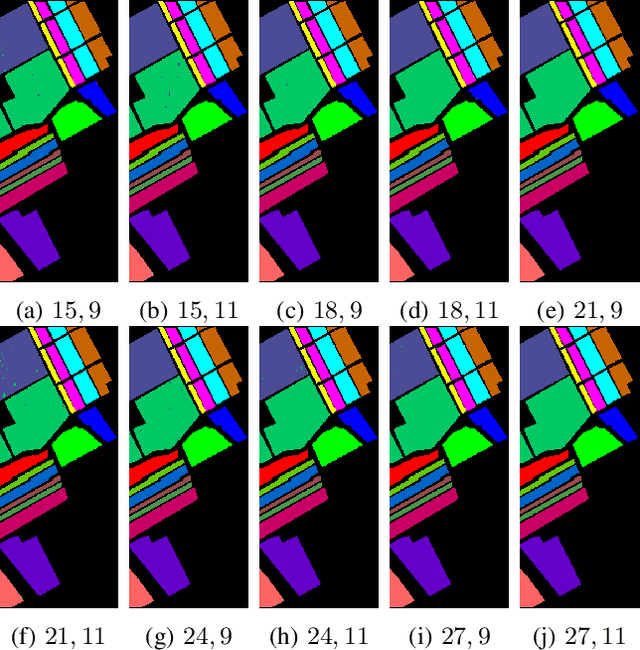
Abstract:Convolutional Neural Networks (CNN) has been extensively studied for Hyperspectral Image Classification (HSIC) more specifically, 2D and 3D CNN models have proved highly efficient in exploiting the spatial and spectral information of Hyperspectral Images. However, 2D CNN only considers the spatial information and ignores the spectral information whereas 3D CNN jointly exploits spatial-spectral information at a high computational cost. Therefore, this work proposed a lightweight CNN (3D followed by 2D-CNN) model which significantly reduces the computational cost by distributing spatial-spectral feature extraction across a lighter model alongside a preprocessing that has been carried out to improve the classification results. Five benchmark Hyperspectral datasets (i.e., SalinasA, Salinas, Indian Pines, Pavia University, Pavia Center, and Botswana) are used for experimental evaluation. The experimental results show that the proposed pipeline outperformed in terms of generalization performance, statistical significance, and computational complexity, as compared to the state-of-the-art 2D/3D CNN models except commonly used computationally expensive design choices.
Towards the Internet of Robotic Things: Analysis, Architecture, Components and Challenges
Jul 08, 2019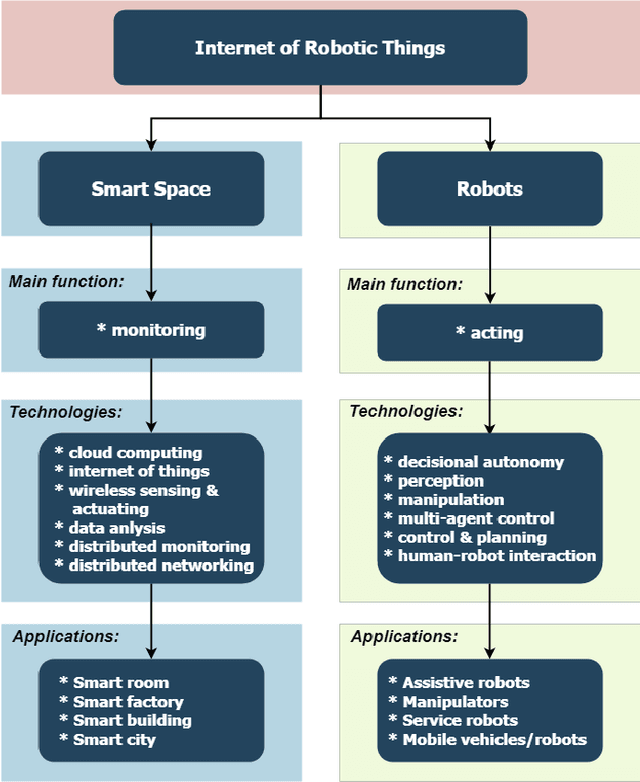
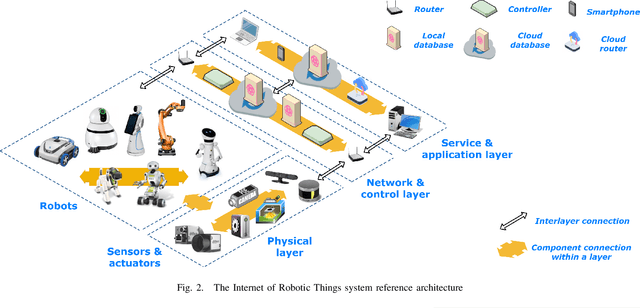
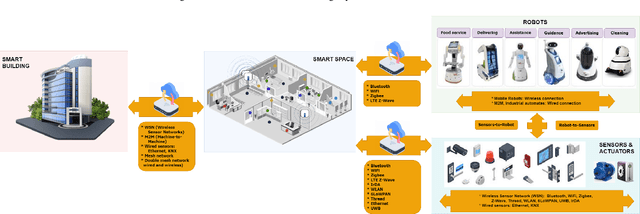
Abstract:Internet of Things (IoT) and robotics cannot be considered two separate domains these days. Internet of Robotics Things (IoRT) is a concept that has been recently introduced to describe the integration of robotics technologies in IoT scenarios. As a consequence, these two research fields have started interacting, and thus linking research communities. In this paper we intend to make further steps in joining the two communities and broaden the discussion on the development of this interdisciplinary field. The paper provides an overview, analysis and challenges of possible solutions for the Internet of Robotic Things, discussing the issues of the IoRT architecture, the integration of smart spaces and robotic applications.
Towards Anthropo-inspired Computational Systems: the $P^3$ Model
Jun 10, 2016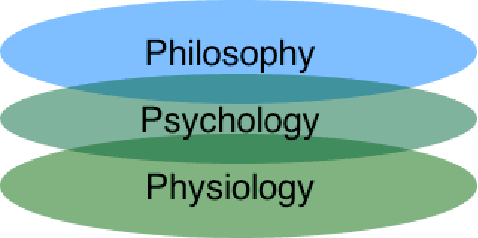

Abstract:This paper proposes a model which aim is providing a more coherent framework for agents design. We identify three closely related anthropo-centered domains working on separate functional levels. Abstracting from human physiology, psychology, and philosophy we create the $P^3$ model to be used as a multi-tier approach to deal with complex class of problems. The three layers identified in this model have been named PhysioComputing, MindComputing, and MetaComputing. Several instantiations of this model are finally presented related to different IT areas such as artificial intelligence, distributed computing, software and service engineering.
 Add to Chrome
Add to Chrome Add to Firefox
Add to Firefox Add to Edge
Add to Edge